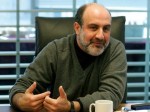Take a look at Nassim’s Small is Beautiful: Risk, Scale and Concentration.
SMALL IS BEAUTIFUL: RISK, SCALE AND CONCENTRATION
Chapter Summary 17: We extract the effect of size on the degradation of the expectation of a random variable, from nonlinear response. The method is general and allows to show the “small is beautiful” or “decentralized is effective” or “a diverse ecology is safer” effect from a response to a stochastic stressor and prove stochastic diseconomies of scale and concentration (with as example the Irish potato famine and GMOs). We apply the methodology to environmental harm using standard sigmoid dose-response to show the need to split sources of pollution across independent (nonsynergetic) pollutants.

